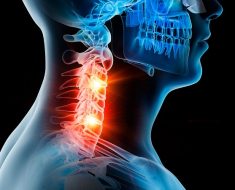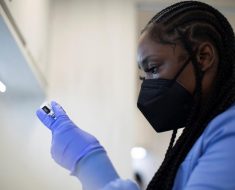Hope for coeliac patients as scientists find an injection of a tiny ‘Trojan horse’ particle hiding gluten inside can teach the immune system to not attack the intestines
- Northwestern University scientists gave 17 patients the pioneering treatment
- It hides gluten inside a nanoparticle that the immune system thinks is friendly
- This stops the body from attacking gluten, which damages the small intestine
Thousands of coeliac patients could one day eat gluten again without harm – by taking an injection that teaches their immune system it is safe.
Scientists gave 17 patients the pioneering treatment, which hides the allergen inside a nanoparticle that the immune system thinks is friendly.
This prevents the body attacking gluten, which damages the small intestine and disrupts the body’s ability to absorb nutrients from food.
Patients fed gluten for two weeks after receiving the experimental injection had 90 per cent less inflammation in their intestine, results showed.

Scientists gave 17 patients the pioneering treatment, which hides the allergen inside a nanoparticle that the immune system thinks is friendly
Northwestern University scientists, who developed the treatment, believe it could treat a host of other auto-immune diseases.
They claim they could enclose a protein from pancreatic cells inside the same nanoparticle to induce tolerance to insulin in type 1 diabetics.
Professor Stephen Miller and team have spent decades refining the ‘Trojan horse’ technology.
Discussing the promising results of the phase two trial, he said: ‘This is the first demonstration the technology works in [coeliac] patients.’
Figures suggest around one in every 100 Britons and Americans have the condition, for which the only treatment is a life without gluten.
This protein, usually derived from wheat, is found in pasta, most types of bread, breakfast cereals, biscuits and cakes.
The condition can cause stomach upsets, fatigue and more serious problems for coeliacs.
Professor Miller said: ‘Doctors can only prescribe gluten avoidance, which is not always effective and carries a heavy social and economic toll for coeliac patients.’
WHAT IS COELIAC DISEASE?
Coeliac disease is a genetic autoimmune disorder in which gluten leads to damage in the small intestine.
Gluten provokes inflammation in the small intestine which affects the body’s ability to absorb nutrients from food.
The condition is estimated to affect one in 100 people worldwide.
One percent – or three million Americans – are living with coeliac disease.
There are more than 200 symptoms of coeliac disease but the more common ones are:
- Abdominal bloating and pain
- Chronic diarrhea
- Vomiting
- Constipation
- Pale, foul-smelling, or fatty stool
- Weight loss
- Fatigue
The only treatment for the disease and is a strict gluten-free diet.
Only foods and beverages with a gluten content less than 20 parts per million are allowed.
Source: Celiac Disease Foundation
The experimental treatment, presented at the European Gastroenterology Week conference in Barcelona, could change that.
The immune system is not alarmed when it spots the gluten-loaded nanoparticle in the blood because it treats it as harmless debris.
Professor Miller said gluten is presented to vacuum cleaner-like cells called macrophages in a way that says ‘No worries, this belongs here’.
‘The immune system then shuts down its attack on the allergen (gluten), and the immune system is reset to normal,’ he added.
In the trial, the CNP-101 nanoparticle – which degrades in the body – was loaded with gliadin, the major component of dietary gluten.
All of the 34 patients were fed gluten for 14 days, including 3g per day for three days followed by 6g per day for the remaining time.
The amount of gluten in a slice of bread can range from approximately 2g to 4g, according to Coeliac Australia.
Half of the volunteers were given the treatment, the others were not. Six of the volunteers who received a placebo had to drop out because of their symptoms.
Results showed the CNP-101 treatment blocked the activation of T cells, which causes inflammation and damages the intestine.
Dr Ciaran Kelly, professor of medicine at Harvard Medical School and director of the Celiac Center at Beth Israel Deaconess Medical Center, presented the study.
He said: ‘Coeliac disease is unlike many other autoimmune disorders because the offending antigen (environmental trigger) is well known — gluten in the diet.
‘This makes coeliac disease a perfect condition to address using this exciting nanoparticle induced immune tolerance approach.’
Side effects of the injection, seen in up to three quarters of patients, included nausea, headaches, abdominal pain and back pain.
Japanese pharmaceutical firm Takeda has acquired the global rights to the experimental treatment in a deal worth $420million.
COUR Pharmaceuticals, which hold the licence to the technology, will trial whether the same technique works for MS patients or peanut allergy sufferers.
Source: Read Full Article





